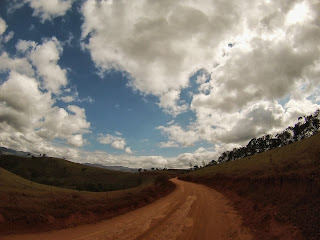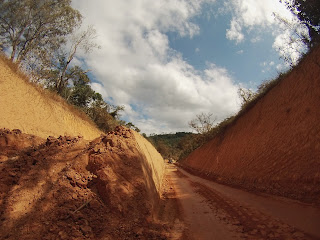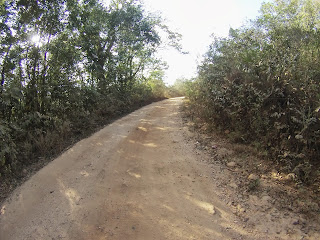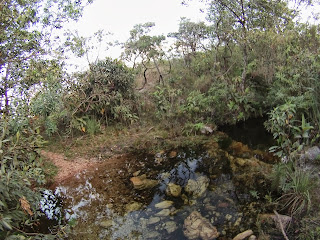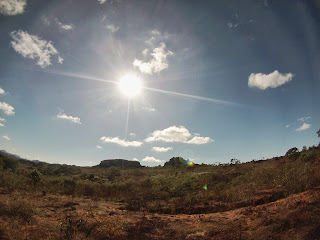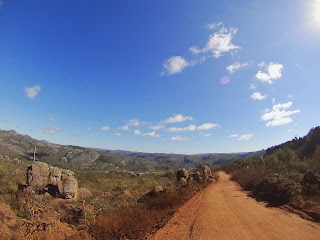From
Corregos, beautiful rolling hills in the sun until Santo Antonio do Norte.
There I ate lunch and watched the Pope give mass in São Paulo. I remembered the Argentinians from Ouro Preto who were in Brasil to see the Pope’s first
visit to South America. The Pope spoke a strange Portuguese. 500,000
Argentinians came to Brasil to see the Argentinean Pope, his first visit
abroad.
I
knew from the profile that the climb would be very difficult. Several times
when the grade surpassed 20%, all I could do was push the bike, and even then I
wondered if it was possible. But unlike the trails in Lago del Desierto, where
porting was required, these roads were not so steep as to require porting, and
I could push the bike through the steepest stretches and continue. The top of
the mountain revealed raw wilderness, and below, farm valleys. Orange silt,
white sand, rocks, pock-marked stretches, dry river beds, cows, horses, an
occasional motorcycle. It was fortunate that the steepest sections of the climb
were shaded, and the descents were in the bright sun and blue skies.
I
had said goodbye earlier to Toni, who ran the pension, and he packed me a
sandwich of home-made wheat bread, lettuce, ham, and cheese. For breakfast I
ate a rich bolo de chocolate his wife had made. Toni owned two buildings, the
pension, and a supermarket in Corregos.
I
arrived in Itapanhoacanga and didn’t think I could make it to Alvorado de Minas
due to the climbing, and certainly not Serro. But there was a possibility to
take the paved roads 25km to Serro. An old woman told me to stay in the city
and said the other cities had nothing her city didn't have. The man at the
supermarket told me I should also rest in the city. It made me happy to feel
welcomed.
I
went in search of the pension but nearly climbed from the city when I decided I
was lost and returned.
I
asked a boy about the pension and he asked me if I was Italian.
I
asked a woman and she and her friend gave me conflicting directions. Go left,
go right, it’s near, it’s far, that sort of thing. I told them that in such a
small town, I would find the pension, and if not, I would return to their
doorstep to sleep.
I
turned down a street and asked the neighbors--who lived right next door to the
pension--where I could sleep for the night. Somehow, they, too, sent me in the
wrong direction. Then another woman took charge. She walked in the middle of
the street, told me to listen to no one but her, and led me to the pension,
totally unmarked and invisible from the main street.
Edi
opened the pension 5 years ago as he wanted more privacy and wanted to live
somewhere were he could work and be away from his parents at the same time. Most
of his business came in one stretch: for 2 years 30 workers for Anglo-American
lived inside his 4 large rooms (dormitory style, with bunk beds). He served
them lunch and dinner for them all by himself. I asked how it was possible for
him to do this all alone. “I had a woman to help me with some preparation and
with cleaning. I had a guy come in the morning to bring pastries for breakfast,
and only 15 workers ate lunch, and 15 workers ate dinner, because they worked
in shifts. Understand? Anyway, I love to cook, I have been doing it for 14
years and it is the only thing I know how to do. One day I will go to the US
and cook there. There are lots of jobs for Brazilians to cook there, right?”
I
told him miniero cuisine was among the best I had ever eaten and that if he
could cook that food in the US, everyone would love it. But I told him that
living in the US was complicated. I myself had left.
Edi
said electricity came to the village 15 years ago. Before then, you heated
water with wood, you cooked with wood. I had seen men dragging large piles of
wood today as I rode, and I thought it strange. I remembered how water was
heated by wood in Northern Argentina and I remember how wood was used
extensively in Southern Chile. He didn’t like the kerosene lamps back them, he
didn’t like to use wood to heat the water. But the flavor of the wood for
cooking was without comparison. I agreed. I still think the best food I’ve had
was cooked by João in Lagoa Dourada, wood stove, 8 reis.
I
ate Edi’s food that night. He prepared a
huge spread in 20 minutes. The fresh tomatoes and lettuce were washed and
served from his garden that the horses had earlier attempted to eat. Carne
cozida, a delicate meat flank cooked with pimenta and onions in a rich brown
grazy, macahao, an al dente spaghetti sauteed in butter, rice, beans, and
farofa, a milled wheat powder sauteed with pork and onions. If Edi leaves,
Brasil will not taste the same.
The
drunk I had run into earlier came to eat as well. The drunk had earlier offered
me cans of beer when I was looking for the pension. It was tempting, but I knew
better—I needed real calories, not beer. He was very sloppy and I had to direct
him to the kitchen twice to find food. On television, the Pope with still in São Paulo, this time visiting a hospital, then shaking hands in the pouring
rain.
I
slept from 7:30 until 1 that morning when I was woken up by blaring music and
fireworks, which continued until 3. Atletico from Minas Gerais had just won the
Copa Libertadores against Paraguay, the first time in the club’s
105 years. It was a big deal, and even though I was exhausted I tried to
celebrate and sing along, paralyzed with fatigue in bed.
I didn’t leave Itapanhoacanga until noon. I had breakfast with
Edi and then hit up the local internet salon. I was looking forward to a day of
paved roads—my legs were shot and I wanted to take a rest day by riding the
pavement. To leave the Estrada Real would be hard but I needed the rest.
By
the time I was done with the internet, it was 11 and I knew I could eat Edi’s
almoço—his dinner was outstanding, and his almoço had to be even better. People
began to pile in. I sat with a doctor from Belo Horizonte who was travelling,
doing house calls. He kept filling my glass with cola and the gesture was very
friendly as I was craving “refrigerantes.” I told him about my
journey and camping one night at the church in Japeri. He leaned in to the table,
and whispered, in English, “Be careful with the priests.” On the television,
the Pope had returned to Rio for another round
of visits.
I wanted to ride asphalt to Milho Verde but it wasn’t to
be. I rode the Estrada Real to Serro on rolling dirt roads, much of which was
under construction in deep mud. Like the Carretera Austal, these sections may
be the last parts of Brasil a man can ride before they are paved. I hope the
paving is limited, as a man learns things about land and movement and nature
and history and effort on unpaved roads. Unpaved roads are a living link with
the way people once traveled. Unpaved roads change constantly and require more
skill, more anticipation, more resolve, more spontaneity.
Serro was a very old and rich town built by gold and
diamonds. Huge paving stones, 200 years old, covered the streets and rattled
the bike. Beautiful and old churches perched up everywhere, overlooking the
valley. I thought about my journey and the state of the bike. I remembered what
my father had told me earlier when I asked him the following:
“How long shall I continue?”
“Continue until day, night, cold, heat no longer have
meaning.”
And I realized day, night, cold, and heat no longer had
meaning.
I rested a day in Serro, sleeping until 1 in the afternoon. I
limped around the impossibly steep streets of the city, exploring the churches
and local museums. The buildings were beautiful but did not affect me.
I believed that if I arose very early and attacked the roads
all day long, only carrying the smallest possible amount of water, and no food,
with me, I could cover the 62km to Diamantina ,
the end of the Estrada Real. That would be the end of the journey for now.
I had problems with the front brake earlier, attributable, I
thought, to the positioning of the tent on the front rack. The v-brake
continued to pop off, but this time, nothing would help. I looked closely at
the opening to the v-brake stop and realized the hole had widened considerably
and I needed pliers to crush the opening back into shape. Pliers I did not
have. I tried with electrical tape to secure the v-brake but it did not work.
Without the front brake, I would be at the mercy of one brake, and in my
experience riding, problems mount en mass, and I
figured I would ride off the road or into a mining truck with just one brake.
I rode into a posto de gasolina and walked up to a table of
tools and asked a fella if I could borrow a strong set of pliers for a few minutes.
He was very generous and offered me any tools I needed. 4 guys on motos saw me
begin to work and held my bike upright. All of them immediately saw and
understood my problem and what I was doing to fix it. One guy centered the
brake for me while I tightened the hole with the pliers. I fixed it in a few
minutes.
I asked the motorcyclists if they had problems in the sand.
One responded: “Me, no, but them (he points to his three friends), yes.” They
laughed. I laughed nervously with everyone, still thinking about the sand.
I rode the pavement to Milho Verde (it is a section of the
Estrada Real that is paved) where at the base of the town a wickedly steep
ascent led me to the town center. A couple from BH were running the ascent and
at the top I asked them if running was popular in Brasil. They said it was
growing. I stopped for yogurts and cookies and thought I could still make it
to Diamantina .
Then the dirt roads resumed and the familiar sand was
everywhere. I straddled the bike and pushed through the beautiful white sand. I
was at peace. I was beyond distance and effort. There was the beautiful land
and I was happy to be alive and happy to move through such beauty, whether
pushing, walking, running, or riding.
I passed through two small towns and stopped at the last for
a large bottle of Guarana and some more cold yogurt drink. I asked an old
man—old men, in my experience, are brilliantly accurate in their knowledge of
old roads: they correct my maps, they tell me in exact detail the location and
duration of ascents and descents; they tell me if the climbing is wicked or
gentle —about the road ahead of me. He said the climbing was hard—three ascents—the last the steepest but the shortest.
It was pure raw beauty, the canyons and the mountains and
the brittle rock formations littered in astounding clumps. But I rode in
denial. In three hours I could not ride 32km of such mountains and in such
sand. By 5, I was 17km away from Diamantina . I
had a half water bottle of water and a handful of oatmeal and a few tablespoons
of powdered milk. Food wasn’t a worry because I knew I could ride for a full
day without food. But I had to find water.
As I rode I saw a small wood bridge and I could hear the
happy sound of water. It was a clear stream. I danced and yelped in joy and
filled my 6 liter bag with stream water. I was high in the mountains in Minas
Gerais and the sun was setting and I could see the valleys from all sides. I
saw a small abandoned home nearby and road to it. I set up the tent and laid
out gear inside. I heard the sound of the stream nearby. I walked through tall
grass and waded into the stream and bathed and washed my filthy shirt.
As I walked back to my tent, shivering, my face was braced
with a deep, peaceful smile. The sky turned pink, purple, yellow. And then the
sky turned to its clear nighttime black through which a man can see deep into
the galaxy of stars and in a full moon he does not need light as it is
strangely given to him in sudden softness as the sun rests for the night.
I had often wondered, as I was riding, how Minas Gerais was
so green when no rain fell and with such an intense sun burning down on the
trees and brush. I awoke that morning and my tent was saturated in a thick dew
and the sleeping bag was soaked. The sky gives water to the land as it sleeps
at night. The cold welcomes the clouds to visit the trees and the ground and
the brush and vegetation drinks in sleep in the cool darkness. The sun then rises
sharply and with heat, burning off the night’s water.
I had 15km of mountains to Diamantina
but neither the sand, the climb, nor the rough descent could prevent me from
arriving that day. I dried the tent and sleeping bag in the sun and looked
forward to eventually finding coffee and food. I set off and was met by the
white sand and steep mountains and then I began to descend. By 9:30 I had
reached a home that was also a bar and I went to the counter and asked for a
coffee and drank 4 large glasses of sweet coffee standing up and manically
describing my days to the hapless owners. I ordered a hotdog pastry and ate
that too and drank still more coffee. I told everyone to go with God and they
told me the same.
I rode the final climb into Diamantina
and it was 33 degrees and the sun was strong. I pushed the bike up the steep
cobblestone streets and arrived at the festa do inverno and there were many
near the main cathedral dressed in white and blue and had ankle cymbals from
Mozambique and danced traditional African dances and I saw the king and queen of
the region walk into the cathedral, ushered with large umbrellas to shade from
the sun. This was the end of the Estrada Real.





